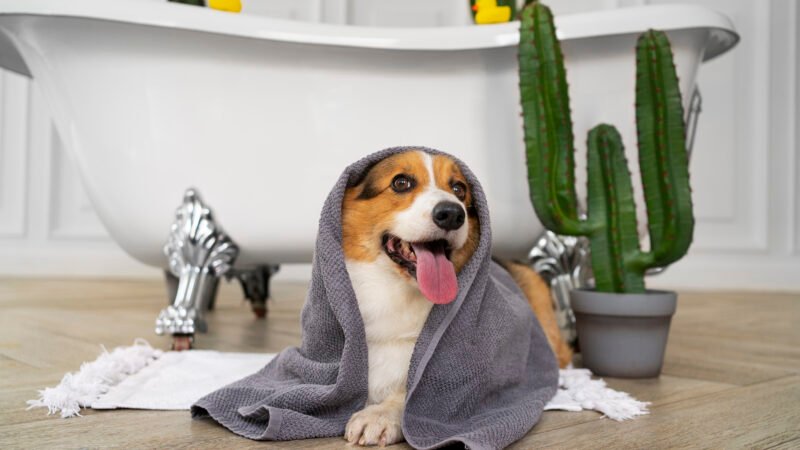Must-Read for Pet Parents:
A Comprehensive Guide to Dog Skin Health and Bathing Tips
Your dog’s skin is its largest organ, covering roughly one-quarter of its body. It protects against bacteria, parasites, and environmental hazards, regulates body temperature, and secretes natural oils that keep the coat shiny. Neglecting proper dog skin care and dog hygiene can lead to itching, redness, bacterial infections, flea infestations, hair loss, and even chronic skin conditions.

Daily Skin Care Essentials
Regular Skin Inspections
Gently run your hands over your dog’s body at least once a week to check for redness, hair thinning, parasites (fleas, ticks), or unpleasant odors.
Consult your veterinarian immediately if you notice any abnormalities.
Optimal Bathing Frequency
Short-haired breeds (e.g., Boxers, Dachshunds): bathe 1–2 times per month.
Long-haired breeds (e.g., Golden Retrievers, Samoyeds): bath every 3–4 weeks, depending on outdoor activity level.
Avoid over-bathing to preserve the skin’s natural barrier and prevent dryness or irritation.
Choose Gentle, Dog-Specific Products
Use a pet shampoo with a pH close to canine skin (around 6.2–7.4).
Avoid harsh human shampoos, soaps, or products containing fragrances and preservatives.
Opt for formulas with natural, soothing ingredients like oatmeal and aloe vera when needed.
Proper Bathing Technique
Adjust Water Temperature: Aim for 86°F–95°F (30°C–35°C) to avoid heat or cold stress.
Wet Thoroughly: Gently wet the coat to avoid shocking the skin.
Lather Evenly: Apply shampoo from the neck toward the tail, massaging lightly to create a rich lather.
Focus on Problem Areas: Pay special attention to behind the ears, armpits, and groin.
Rinse Completely: Residual soap can irritate; rinse for at least two minutes.
Dry Carefully: Wrap in a towel to absorb excess water; avoid high-heat blow-drying that can damage skin.
Deep Cleaning and Grooming Recommendations
Trim Nails and Foot Fur: Overgrown fur between toes can trap dirt and encourage bacterial growth.
Brush with a Soft Bristle Brush: Removes dead hair and gently massages the skin to stimulate natural oil production and maintain a healthy coat.
Clean Ears and Eye Areas: Use a cotton ball dampened with saline solution or a vet-approved cleaning solution; gently wipe ear canals and eyelids to prevent cysts or crusting.
Oral Hygiene: Bad breath and tartar buildup can impact overall wellness and potentially affect skin health.
Preventing and Addressing Common Skin Issues
Dry, Flaky Skin
Causes: Excessive bathing, low humidity, nutritional deficiencies.
Solutions: Reduce bath frequency, supplement with omega-3 rich oils such as fish oil or flaxseed oil.
Eczema and Allergies
Causes: Food allergies, environmental irritants (grass, chemicals).
Solutions: Implement an elimination diet, perform allergy testing, switch to hypoallergenic grooming products.
Parasite Infestations (Fleas, Ticks)
Causes: Outdoor exposure.
Solutions: Administer veterinarian-recommended flea and tick preventatives, regularly clean bedding and vacuum carpets.
Breed-Specific Skin Care Tips
Short-Haired Breeds (Boxers, Dachshunds, etc.)
Even oil distribution allows for a slightly higher bathing frequency (1–2 times monthly).
Use a foaming shampoo to break down surface oils.
Weekly rubber brush massages stimulate circulation.
Long-Haired Breeds (Golden Retrievers, Samoyeds, etc.)
Pre-bath detangling is crucial to prevent matting.
Follow up with a conditioner to lock in moisture and avoid a brittle coat.
Regularly trim paw and interdigital hair for cleanliness and airflow.
Sensitive-Skinned Breeds (French Bulldogs, Pugs, etc.)
Use tear-free, hypoallergenic formulas.
Keep bath water below 90°F (32°C) to minimize irritation.
Complement with anti-itch sprays or medicated soaks as advised by your vet.
Puppies and Senior Dogs
Puppies: Their skin barrier is immature—bathe every 4–6 weeks.
Seniors: Reduced skin barrier function—bathe monthly and apply topical skin balms for extra protection.
Working & Active Dogs (Herding Dogs, Police Dogs, etc.)
High activity levels increase sweat and oil production—bathe 2–3 times a month.
After training or outdoor work, use pet-safe wipes to remove dirt and sweat.
Small vs. Large Breeds
Small Breeds: Higher body heat, prone to dryness—less frequent baths and post-bath moisturizing sprays.
Large Breeds: Greater skin tolerance—adjust bathing frequency based on activity and dirt exposure.
Essential Tips for Pet Parents
Seasonal Adjustments: Increase parasite prevention in spring and summer; boost hydration and moisturizing in fall and winter.
Balanced Nutrition: High-quality proteins, vitamins A & E, and essential fatty acids support skin repair and hydration.
Mental Well-Being: Stress and anxiety can manifest as skin issues—ensure regular exercise, playtime, and companionship.
Routine Vet Check-Ups: Annual full-body exams help catch skin or health problems before they escalate.
